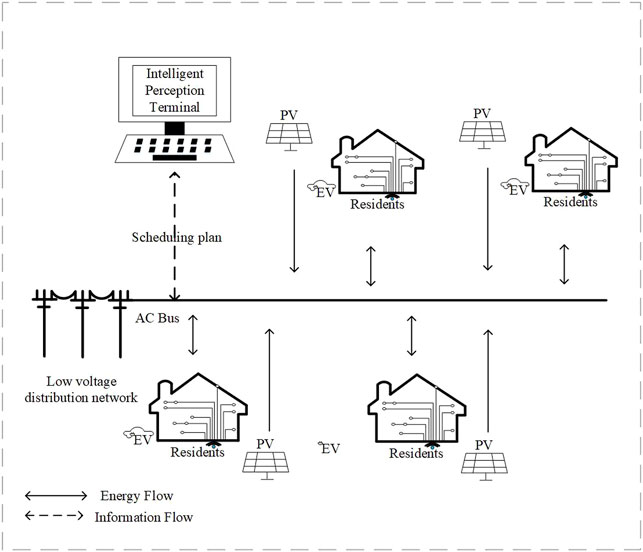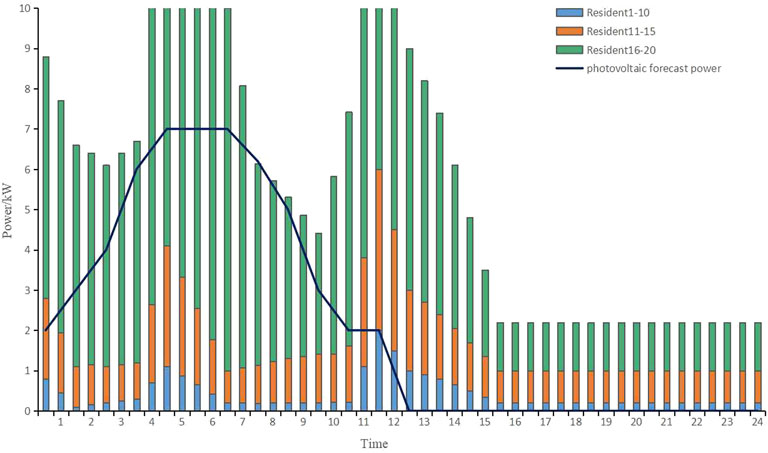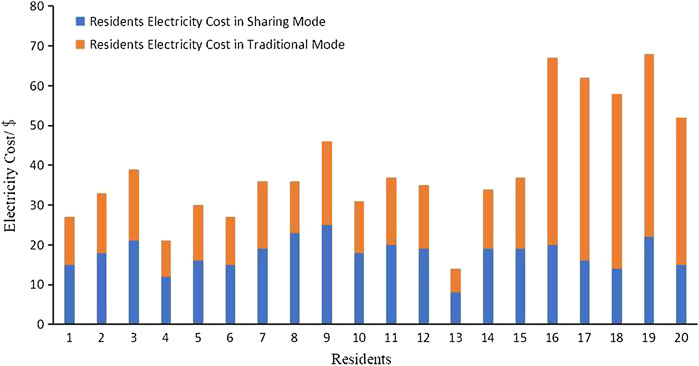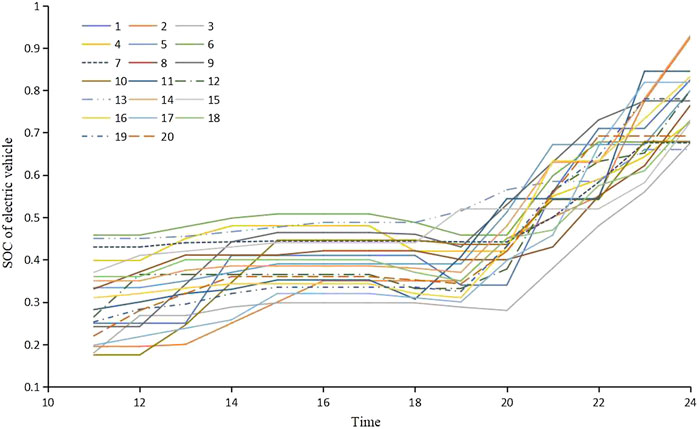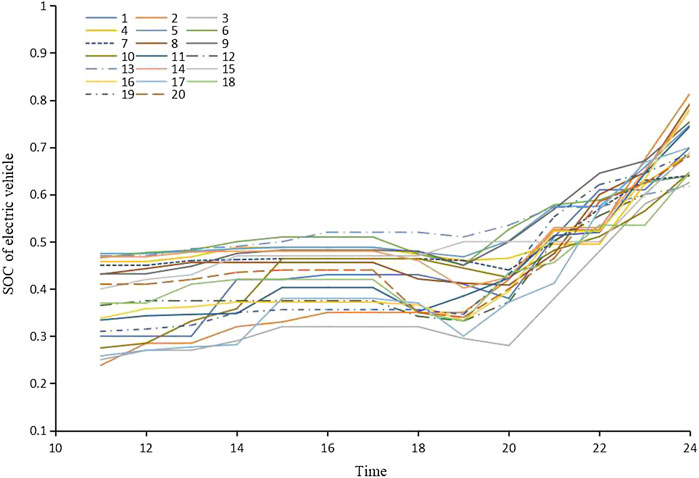- State Grid Zhejiang Anji County Power Supply Co., Ltd., Huzhou, China
With the gradual increase in the deployment of distributed power sources and electric vehicles, the coordinated dispatch of clean power is of great significance to improve the economics of electricity consumption by prosumers and promote the consumption of renewable energy. On the basis of considering photovoltaic as a shared power resource, a low-voltage distribution network electric vehicle and distributed photovoltaic coordinated management and control strategy was proposed, and a day-ahead dispatch model of photovoltaic and electric vehicles for prosumers was established, which also considered the total cost of electricity consumption and two targets for photovoltaic consumption. The NSGA-2 algorithm is used to solve the model to obtain the Pareto optimal solution set, and the satisfaction evaluation method is used to select the optimal compromise solution. Based on the cloud-edge collaborative mechanism, the aforementioned technologies are deployed in the intelligent perception terminal device to execute downward computing, storage, and resource management strategies of the cloud station. A 24-period simulation calculation was performed on a low-voltage distribution network with 20 households. The results show that the proposed collaborative management and control strategy is beneficial to improve the economic efficiency of users’ electricity consumption and promote the consumption of clean energy.
1 Introduction
As the world’s energy structure is accelerating toward low-carbon evolution, distributed photovoltaics are developing rapidly. However, with the increase in the penetration rate of distributed photovoltaics, the intermittent impact of its output on the system cannot be ignored (Haque and Wolfs, 2016; Yao et al., 2019). In recent years, the sharing model has promoted the efficient use of resources. Households sharing photovoltaic power generation in the low-voltage distribution network can promote the consumption of clean energy and improve the economic efficiency of community power consumption (Zhou et al., 2015; Xiong et al., 2020). At the same time, the proportion of electric vehicle users is gradually increasing. In the context of distributed photovoltaic power generation access, reasonable control of the charging and discharging of electric vehicles can improve photovoltaic consumption and reduce electricity expenditure. Therefore, it is necessary to conduct research on collaborative management and control technologies such as distributed photovoltaics and electric vehicles in the low-voltage distribution network under the power resource sharing mode. On the other hand, low-voltage distribution terminals collect massive measurement data and act as the management center. It can form the operation management system of cloud-edge collaboration with cloud station. Based on cloud-edge collaborative architecture, data collection, status perception, and resource collaboration for low-voltage distribution systems can be achieved. It enables distributed intelligence and improves data edge utilization.
The low-voltage power distribution community realizes power dispatching processes including power purchase, power sharing, and demand response (DR), etc., through the intelligent perception device to meet the load demand of the residents (Zhao et al., 2020; Zhao et al., 2021). Erdinc et al. (2015) studied the operating strategies of smart homes with electric vehicles and energy storage under the guidance of real-time electricity prices. Zhong et al. (2018) established a smart community energy management system optimization scheduling model, which allows distributed power sources to smoothly connect to the grid by scheduling the flexible load working time of each user and the charging and discharging power of electric vehicles in each period. However, the aforementioned literature does not consider the impact of the power-sharing mode on the power consumption economy of the prosumers and the consumption of clean energy. Joo and Choi (2017) consider the power-sharing behavior between adjacent users, and Wu et al. (2018) consider the power sharing between smart buildings, but these literatures also only study the impact of power-sharing mode on the economics of the park, how to make it more comprehensive. Analyzing the effect of power-sharing mode on clean energy consumption requires further exploration.
This study proposes a coordinated management and control strategy for low-voltage distribution network electric vehicles and distributed photovoltaics (Zhang et al., 2021) and establishes a day-ahead dispatch model for photovoltaics and electric vehicles for prosumers, which also considers the total cost of residential electricity and the amount of clean energy consumption. The goal is to use the NSGA-2 algorithm to solve the model, obtain the Pareto optimal solution set, and use the satisfaction evaluation method to select the optimal compromise solution. Based on the cloud-edge collaborative mechanism, the previous technologies are deployed in the intelligent perception terminal device to receive and execute downward computing, storage, and resource management strategies of the cloud station. The simulation results show that the collaborative management and control of electric vehicles and distributed photovoltaics can significantly improve the economic efficiency of electricity consumption and promote the consumption of clean energy.
2 Cloud-Edge Collaborative Mechanism
The devices in the power grid generate a large amount of data, which is uploaded to the cloud for processing, causing great pressure on the cloud. In order to share the pressure of the central cloud node, an intelligent perception terminal device set up in a low-voltage distribution network can be responsible for data calculation and storage within its own scope. At the same time, most of the data is not one-time data, and the processed data still needs to be gathered from terminal nodes to the central cloud. Cloud computing can do big data analysis and mining, data sharing, and training and upgrading of algorithm models. The cooperation and integration of the cloud and terminal are the cloud-edge collaborative mechanism. Based on the cloud-edge collaborative mechanism, the intelligent perception terminal device is set up in a low-voltage distribution network, which receives and executes the downbound computing and storage resource scheduling management strategies of the cloud station to meet the allocation of resources required for tasks and reduce energy consumption. The intelligent perception terminal device is responsible for formulating the day-ahead dispatching plan for the low-voltage power distribution network, monitoring and managing flexible loads, so as to reduce the cost of electricity and promote the consumption of clean energy. Each user in the low-voltage power distribution network has distributed photovoltaics, charging piles (support electric vehicle charging and discharging), and smart sockets. The energy flow and information flow in the power-sharing mode are shown in Figure 1. Specifically, households’ photovoltaic power generation prioritizes the use of their own household’s daily load, that is, the PV-to-house (PV2H) process; when the photovoltaic power generation is surplus, it can be shared with other households through the intelligent terminal perception device, that is, the PV-to-community (PV2C) process. After the electric vehicle with V2G function is used and connected to the charging pile, it uses the intelligent perception terminal device PS-CEMS to control the charge and discharge power to reduce the charging cost and promote the consumption of distributed photovoltaics.
3 Coordinated Management and Control Model of Electric Vehicles and Distributed Photovoltaics for Users
3.1 Objective Function
In this study, with the goal of minimizing the total cost of residential electricity and maximizing the consumption of distributed photovoltaics, a multi-objective optimization model for the coordinated management and control of electric vehicles and distributed photovoltaics in the low-voltage distribution network is constructed.
3.1.1 Resident Electricity Costs
The goal was to minimize the total electricity cost of residents, that is, the minimum cost of purchasing electricity from the grid, as shown in the following equation:
In the formula, t and h are, respectively, time period and user number; T is the optimization period; N is the number of residents; Mb t is the electricity purchase price of each time period; and Pg h,t and Pev_g h, t are, respectively, the power purchased from the grid by household daily load and the power purchased from the grid by the EV.
3.1.2 Distributed Photovoltaic Consumption
With the maximum distributed photovoltaic absorption as the target, the objective function is shown as follows:
3.2 Constraint Condition
1) Constraints on household power balance
In the formula,
2) Constraints on sharing power balance between the low-voltage distribution system
In the formula,
3) Line constraint
In the formula,
4) Photovoltaic output constraint
According to the situation that photovoltaic power generation can be scheduled and considering the loss in the photovoltaic inverter process, the photovoltaic output balance constraint is as follows:
In the formula,
5) EV charging and discharging constraints
In the formula,
In the formula,
4 NSGA-2 Algorithm for Solving Multi-Objective Problems
Aiming at the coordinated management and control model of electric vehicles and distributed photovoltaics in the low-voltage distribution network established earlier, this study needs to solve the multi-objective optimization problem. A multi-objective genetic algorithm (MGA) is an evolutionary algorithm used to analyze and solve multi-objective optimization problems. Its core is to coordinate the relationship between each objective function and find the optimal solution set that makes each objective function reach a relatively large (or relatively small) function value as much as possible. The NSGA2 algorithm is a multi-objective genetic algorithm with the largest influence and the widest application range among many objective optimization genetic algorithms. It is superior to the NSGA algorithm: it adopts a fast non-dominated sorting algorithm, and the computational complexity is greatly reduced compared with NSGA. Crowding degree and crowding degree comparison operators are used to replace shareQ, which needs to be specified, and are used as the winning criteria in the peer comparison after quick sorting so that the individuals in the quasi-Pareto domain can be extended to the whole Pareto domain and evenly distributed to maintain the diversity of the population. The elitist strategy is introduced to enlarge the sampling space, prevent the loss of the best individual, and improve the speed and robustness of the algorithm. It is suitable for application to complex and nonlinear multi-objective optimization problems. The algorithm flow can be found in the literature (Lei and Yan, 2019).
The multiple Pareto optimal solution sets are obtained by the NSGA-2 algorithm to solve the model, so multiple Pareto optimal solution sets need to be screened and compared to determine the optimal compromise solution and so as to determine the source-load interaction peak shaving optimal decision plan. The evaluation results of each objective function value are more than “satisfactory” and “unsatisfactory”. In the classical set, the eigenfunction can only take two values of 0 and 1, while in the fuzzy set, the value range of the eigenfunction expands from the set of two elements to the interval of (0,1). Therefore, this study uses the satisfaction evaluation method to select the optimal compromise solution. The fuzzy membership function is the satisfaction value of the objective function corresponding to each Pareto solution, and the optimal compromise solution is found by comparing the respective satisfaction. Therefore, this study uses the satisfaction evaluation method to select the optimal compromise solution (Tang et al., 2008; Kannan et al., 2009). The fuzzy membership function is the satisfaction value of the objective function corresponding to each Pareto solution, and the optimal compromise solution is found by comparing the respective satisfaction. The fuzzy membership function is:
In the formula, fi,k is the value of the ith objective function in the kth Pareto optimal solution; fi,max and fi,min are the maximum and minimum values of the ith objective function, respectively; when μi,k = 0, μi,k = 1, respectively, the value of the ith objective function is completely unsatisfactory and completely satisfied. Through the aforementioned method, multiple Pareto optimal solutions are obtained, and the standardized satisfaction value μk of these Pareto optimal solutions is obtained according to the following formula, and the maximum solution is the optimal compromise solution.
In the formula, m is the number of objective functions to be optimized; μk is the standardized satisfaction value of the kth Pareto optimal solution.
5 Analysis of Coordinated Control Results of Electric Vehicles and Distributed Photovoltaic in the Low-Voltage Distribution Network
This study takes into account the power-sharing between residents in the low-voltage distribution system and establishes a multi-objective optimization model with the goal of minimizing residential electricity costs and maximizing clean energy consumption. Under the MATLAB 2018b platform, the GUROBI8.0.1 software is called through the YALMIP toolbox to solve the problem, and the computer parameters are Intel Core i5-8400 Q1BVQDIuODA= GHz, 8 GB memory.
5.1 Basic Data
There are a total of 20 users in the power sharing low-voltage distribution system designed in this study, that is, N = 20; the optimization period is T = 24.8:00 a.m. to 9:00 a.m. is set as the first period and 7:00 a.m. to 8:00 a.m. is set as the 24th period on the second day. Conversion efficiency ηdc-ac = 95%, ηac-dc = 95%.
The photovoltaic output curve and load data are shown in Figure 2. The EV parameters of households are shown in Table 1. The price of electricity purchased by users from the grid adopts the time-of-use electricity price, which refers to the industrial electricity price, as shown in Table 2.
5.2 Sharing Mode Analysis
In the power-sharing mode, households’ photovoltaic power generation prioritizes the use of their own household’s daily load; when the photovoltaic power generation is surplus, it can be shared with other households through the intelligent terminal perception device. When the power sharing in the community is not considered, that is, in the traditional mode, the electricity generated by photovoltaic power generation is first consumed by the load in real time, and the surplus electricity can only be discarded. In order to verify the advantages of the sharing mode proposed in this study compared with the traditional mode, the results of multi-objective optimization under the two modes are analyzed separately.
As shown in Figure 3, the NSGA-2 algorithm is used to solve the coordination control model in both the sharing mode and the traditional mode. The steps of the NSGA-2 algorithm are as follows: First, an initial population of N size is randomly generated. After non-dominated sorting, the first generation of the offspring population is obtained through the selection, crossover, and mutation of the genetic algorithm. Second, starting from the second generation, the parent population was combined with the offspring population to carry out a rapid non-dominated sorting, and the crowding degree of individuals in each non-dominated layer was calculated. Suitable individuals were selected to form the new parent population according to the non-dominant relationship and the crowding degree of individuals. Finally, a new population of offspring is generated by the basic operation of the genetic algorithm and so on until the end-of-program condition is met (Deb et al., 2002; Xu et al., 2019). The algorithm parameters are selected as follows: the maximum number of iterations is 500, the population size is 300, the crossover probability is 0.9, and the mutation probability is 0.1. The results are shown in Table 3. Comparing the compromise solution data of the sharing mode and the traditional mode, it can be seen that the total electricity cost of low-voltage distribution network users in the sharing mode is reduced by 93 yuan compared with the traditional mode, and the consumption of clean energy has increased by 241 kW h. Furthermore, compare the electricity costs of users in the two modes as shown in Figure 3. It can be seen from the results in Figure 3 that compared with the traditional model, the electricity cost of the heavy-duty households (households 16–20) under the sharing mode has dropped significantly, while the electricity cost of the households with a lower load level has increased slightly. After energy sharing, the total cost of electricity consumption by users has decreased. Therefore, the power-sharing model effectively improves the economic efficiency of electricity consumption and the consumption of clean energy in the community.
5.3 Analysis of the Charging and Discharging Process of EV
In the two modes, the SOC curves of EV are shown in Figures 4, 5. Electric vehicles are flexible loads with time-shift characteristics. In order to absorb the excess photovoltaic power generation in the system, the electric vehicle load will use electricity. The amount has shifted from the 20–24 period to the 12–16 period. Therefore, during the 12–16 period, the battery energy storage of some electric vehicle users also reached the upper limit of SOC, approaching 1.
6 Conclusion
This study proposes a coordinated management and control strategy for low-voltage distribution network electric vehicles and distributed photovoltaics and establishes a day-ahead dispatch model of photovoltaics and electric vehicles for prosumers, which considers the total cost of electricity consumption and the two goals of photovoltaic consumption. The NSGA-2 algorithm is used to obtain the Pareto optimal solution set, and finally, a compromise solution is given. The results show that the proposed multi-objective optimization model considers the total electricity cost of community residents and the consumption of clean energy at the same time, which is beneficial to comprehensively study the impact of the clean power-sharing mode from multiple aspects. After the sharing of clean energy, the total cost of electricity consumption by users has decreased. The coordinated management and control of electric vehicles and distributed photovoltaics can improve the economics of the system and increase the consumption of clean energy. In the next step, a more comprehensive collaborative management and control strategy will be considered; research and consideration will be given to adding electric vehicles to the sharing mode, and further simulation and application will be carried out.
Data Availability Statement
The original contributions presented in the study are included in the article/Supplementary Material, further inquiries can be directed to the corresponding author.
Author Contributions
The author’s personal contributions are as follows: manuscript writing, JG and YL; data collection, BW and TZ; content and format correction, YZ and ZZ. All authors have read and agreed to the published version of the manuscript.
Funding
This study received funding from the Science and Technology Project of State Grid Zhejiang Electric Power Co., Ltd. (B311UZ220003).
Conflict of Interest
JG, YL, BW, TZ, YZ, and ZZ are employed by State Grid Zhejiang Anji County Power Supply Co., Ltd.
All authors declare that the research was conducted in the absence of any commercial or financial relationships that could be construed as a potential conflict of interest.
Publisher’s Note
All claims expressed in this article are solely those of the authors and do not necessarily represent those of their affiliated organizations, or those of the publisher, the editors, and the reviewers. Any product that may be evaluated in this article, or claim that may be made by its manufacturer, is not guaranteed or endorsed by the publisher.
References
Deb, K., Pratap, A., Agarwal, S., and Meyarivan, T. (2002). A Fast and Elitist Multiobjective Genetic Algorithm: NSGA-II. IEEE Trans. Evol. Comput. 6, 182–197. doi:10.1109/4235.996017
Erdinc, O., Paterakis, N. G., Mendes, T. D. P., Bakirtzis, A. G., and P. S. Catalao, J. (2015). Smart Household Operation Considering Bi-directional EV and ESS Utilization by Real-Time Pricing-Based DR. IEEE Trans. Smart Grid 6 (3), 1281–1291. doi:10.1109/TSG.2014.2352650
Haque, M. M., and Wolfs, P. (2016). A Review of High PV Penetrations in LV Distribution Networks: Present Status, Impacts and Mitigation Measures. Renew. Sustain. Energy Rev. 62, 1195–1208. doi:10.1016/j.rser.2016.04.025
Joo, I.-Y., and Choi, D.-H. (2017). Optimal Household Appliance Scheduling Considering Consumer's Electricity Bill Target. IEEE Trans. Consum. Electron. 63 (1), 19–27. doi:10.1109/TCE.2017.014666
Kannan, S., Baskar, S., McCalley, J. D., and Murugan, P. (2009). Application of NSGA-II Algorithm to Generation Expansion Planning. IEEE Trans. Power Syst. 24 (1), 454–461. doi:10.1109/TPWRS.2008.2004737
Lei, D., and Yan, X. (2019). Multi-objective Intelligent Optimization Algorithm and its Application. North Beijing: Science Press.
Tang, Y., Zhao, Q., Gao, Y., and Chen, Y. (2008). Overview on the Pareto Optimal-Based Multi Objective Evolutionary Algorithms. Comput. Sci. 25–27, 57. doi:10.3969/j.issn.1002-137X.2008.10.005
Wu, J., Ai, X., Zhang, Y., Wang, K., and Hu, J. (2018). Day-ahead Optimal Scheduling for High Penetration of Distributed Energy Resources in Community under Separated Distribution and Retail Operational Environment. Power Syst. Technol. 42 (06), 1709–1719. (in Chinese). doi:10.13335/j.1000-3673.pst.2017.2969
Xiong, L., Liu, X., Liu, Y., and Zhuo, F. (2020). Modeling and Stability Issues of Voltage-Source Converter Dominated Power Systems: A Review. CSEE J. Power Energy Syst. 5, 1–18. doi:10.17775/CSEEJPES.2020.03590
Xu, X., Zhang, Y., Chen, G., Zhang, Y., and Zhang, J. (2019). Optimal Scheduling of Charging for Electric Vehicle Considering Photovoltaic Power Generation. Smart Power 47 (10), 44–50. (in Chinese).
Yao, H., Du, X., Li, T., and Jia, C. (2019). Simulation of Distribution Capacity and Voltage Control Strategy of Distribution Network under High Permeability of Photovoltaic. Power Syst. Technol. 43 (2), 462–469. (in Chinese). doi:10.13335/j.1000-3673.pst.2018.2036
Zhang, K., Zhou, B., Or, S. W., Li, C., Chung, C. Y., and Voropai, N. (2022). Optimal Coordinated Control of Multi-Renewable-To-Hydrogen Production System for Hydrogen Fueling Stations. IEEE Trans. Ind. Appl. 58, 2728–2739. doi:10.1109/TIA.2021.3093841
Zhao, J., Li, L., Xu, Z., Wang, X., Wang, H., and Shao, X. (2020). Full-Scale Distribution System Topology Identification Using Markov Random Field. IEEE Trans. Smart Grid 11 (6), 4714–4726. doi:10.1109/TSG.2020.2995164
Zhao, J., Xu, M., Wang, X., Zhu, J., Xuan, Y., and Sun, Z. (2021). Incidence Convolution Based Low-Voltage Distribution System Transformer-Customer Relationship Identification. IEEE Trans. Power Deliv., 1. (in press). doi:10.1109/TPWRD.2021.3120625
Zhong, H., Han, A., and Zhang, Z. (2018). Research on Optimal Scheduling of Energy Management System Based on MOHSA in Smart Community. Adv. Technol. Electr. Eng. Energy 38 (03), 28–37. (in Chinese). doi:10.12067/ATEEE1806057
Keywords: power resource sharing, prosumer, energy management, distributed generation, cloud-edge collaboration
Citation: Gao J, Lu Y, Wu B, Zheng T, Zhu Y and Zhang Z (2022) Coordinated Management and Control Strategy in the Low-Voltage Distribution Network Based on the Cloud-Edge Collaborative Mechanism. Front. Energy Res. 10:903768. doi: 10.3389/fenrg.2022.903768
Received: 24 March 2022; Accepted: 18 April 2022;
Published: 30 May 2022.
Edited by:
Liansong Xiong, Nanjing Institute of Technology (NJIT), ChinaReviewed by:
Xu Xu, Hong Kong Polytechnic University, Hong Kong, SAR ChinaYi He, Hong Kong Polytechnic University, Hong Kong, SAR China
Ying Wang, Southeast University, China
Copyright © 2022 Gao, Lu, Wu, Zheng, Zhu and Zhang. This is an open-access article distributed under the terms of the Creative Commons Attribution License (CC BY). The use, distribution or reproduction in other forums is permitted, provided the original author(s) and the copyright owner(s) are credited and that the original publication in this journal is cited, in accordance with accepted academic practice. No use, distribution or reproduction is permitted which does not comply with these terms.
*Correspondence: Jiuguo Gao, MjQ2MTExMjcyMkBxcS5jb20=
 Jiuguo Gao
Jiuguo Gao Yang Lu
Yang Lu Bin Wu
Bin Wu Zhixiang Zhang
Zhixiang Zhang